warning light LINCOLN CONTINENTAL 2020 Owners Manual
[x] Cancel search | Manufacturer: LINCOLN, Model Year: 2020, Model line: CONTINENTAL, Model: LINCOLN CONTINENTAL 2020Pages: 609, PDF Size: 6.24 MB
Page 5 of 609

Using MyKey With Remote Start Systems
........................................................................\
.70
MyKey – Troubleshooting ...........................
70
Doors and Locks
Locking and Unlocking .................................
72
Opening the Doors ........................................
78
Emergency Door Release ............................
79
Power Decklid ................................................
79
Soft Closing Door ..........................................
83
Keyless Entry ..................................................
83
Interior Luggage Compartment Release ........................................................................\
85
Security
Passive Anti-Theft System ...........................
87
Anti-Theft Alarm .............................................
89
Steering Wheel
Adjusting the Steering Wheel ....................
90
Audio Control ..................................................
91
Voice Control ...................................................
91
Cruise Control ................................................
92Information Display Control
........................
92
Heated Steering Wheel ...............................
93
Horn ..................................................................
93
Wipers and Washers
Windshield Wipers ........................................
94
Autowipers ......................................................
95
Windshield Washers .....................................
96
Lighting
General Information ......................................
97
Lighting Control ..............................................
97
Autolamps .......................................................
98
Instrument Lighting Dimmer .......................
99
Headlamp Exit Delay ....................................
99
Daytime Running Lamps - Vehicles With: Configurable Daytime Running Lamps
........................................................................\
99
Daytime Running Lamps - Vehicles With: Daytime Running Lamps (DRL) ..............
99
Adaptive Headlamps ..................................
100
Direction Indicators .....................................
100
Welcome Lighting .........................................
101
Interior Lamps ................................................
101Ambient Lighting
..........................................
102
Automatic High Beam Control
What Is Automatic High Beam Control .......................................................................
103
Switching Automatic High Beam Control On and Off .................................................
103
Automatic High Beam Control Indicators .......................................................................
104
Overriding Automatic High Beam Control .......................................................................
104
Windows and Mirrors
Power Windows ............................................
105
Global Opening and Closing ....................
106
Exterior Mirrors .............................................
106
Interior Mirror ................................................
108
Sun Visors ......................................................
109
Sun Shades ...................................................
109
Moonroof .........................................................
110
Instrument Cluster
Gauges ..............................................................
111
Warning Lamps and Indicators ..................
112
2
Continental (CPL) Canada/United States of America, enUSA, Edition date: 201907, Second-Printing Table of Contents
Page 12 of 609

Windshield defrosting system
Interior luggage compartment
release
Jack
Keep out of reach of children
Lighting control
Low tire pressure warning
Maintain correct fluid level
Note operating instructions
Horn control Panic alarm
Parking aid
Parking brake
Power steering fluid
Power windows front/rear
Power window lockout
Requires registered technician
Safety alert
See Owner's Manual See Service Manual
Service engine soon
Passenger airbag activated
Passenger airbag deactivated
Side airbag
Shield the eyes
Stability control
Hill descent control
Trail control
Windshield wiping system
9
Continental (CPL) Canada/United States of America, enUSA, Edition date: 201907, Second-Printing Introduction E161353 E270945 E139213 E231159 E231158 E270849 E270850 E167012 E138639 E163957 E272858 E270969
Page 19 of 609
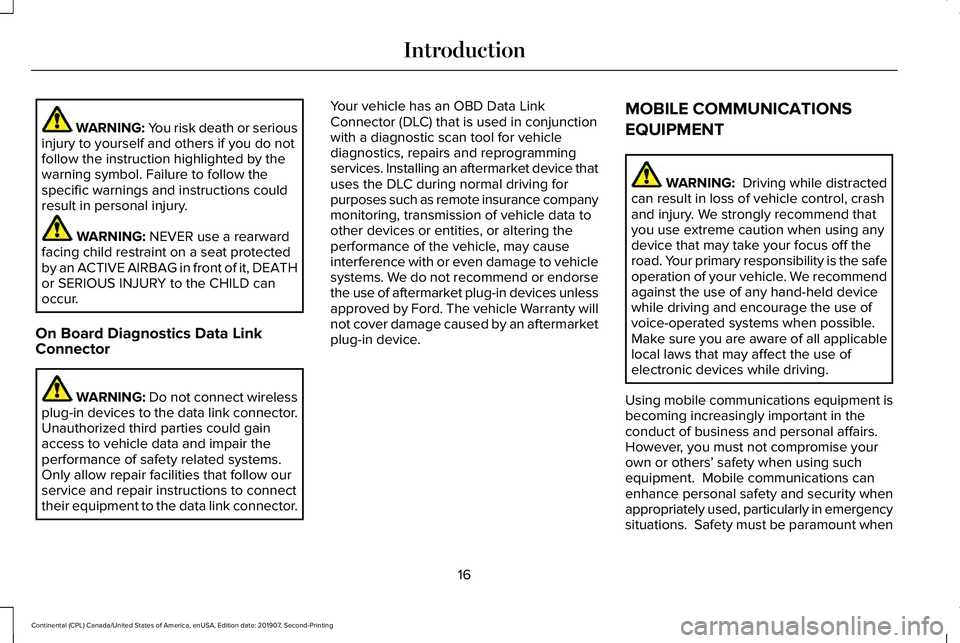
WARNING: You risk death or serious
injury to yourself and others if you do not
follow the instruction highlighted by the
warning symbol. Failure to follow the
specific warnings and instructions could
result in personal injury. WARNING: NEVER use a rearward
facing child restraint on a seat protected
by an ACTIVE AIRBAG in front of it, DEATH
or SERIOUS INJURY to the CHILD can
occur.
On Board Diagnostics Data Link
Connector WARNING: Do not connect wireless
plug-in devices to the data link connector.
Unauthorized third parties could gain
access to vehicle data and impair the
performance of safety related systems.
Only allow repair facilities that follow our
service and repair instructions to connect
their equipment to the data link connector. Your vehicle has an OBD Data Link
Connector (DLC) that is used in conjunction
with a diagnostic scan tool for vehicle
diagnostics, repairs and reprogramming
services. Installing an aftermarket device that
uses the DLC during normal driving for
purposes such as remote insurance company
monitoring, transmission of vehicle data to
other devices or entities, or altering the
performance of the vehicle, may cause
interference with or even damage to vehicle
systems. We do not recommend or endorse
the use of aftermarket plug-in devices unless
approved by Ford. The vehicle Warranty will
not cover damage caused by an aftermarket
plug-in device.
MOBILE COMMUNICATIONS
EQUIPMENT WARNING: Driving while distracted
can result in loss of vehicle control, crash
and injury. We strongly recommend that
you use extreme caution when using any
device that may take your focus off the
road. Your primary responsibility is the safe
operation of your vehicle. We recommend
against the use of any hand-held device
while driving and encourage the use of
voice-operated systems when possible.
Make sure you are aware of all applicable
local laws that may affect the use of
electronic devices while driving.
Using mobile communications equipment is
becoming increasingly important in the
conduct of business and personal affairs.
However, you must not compromise your
own or others ’ safety when using such
equipment. Mobile communications can
enhance personal safety and security when
appropriately used, particularly in emergency
situations. Safety must be paramount when
16
Continental (CPL) Canada/United States of America, enUSA, Edition date: 201907, Second-Printing Introduction
Page 23 of 609
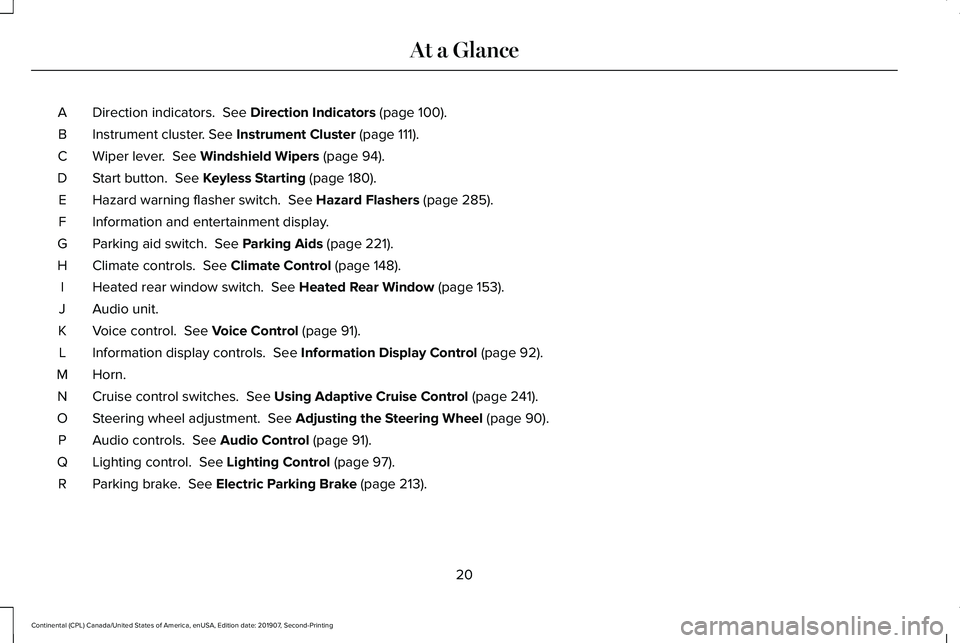
Direction indicators. See Direction Indicators (page 100).
A
Instrument cluster.
See Instrument Cluster (page 111).
B
Wiper lever.
See Windshield Wipers (page 94).
C
Start button.
See Keyless Starting (page 180).
D
Hazard warning flasher switch.
See Hazard Flashers (page 285).
E
Information and entertainment display.
F
Parking aid switch.
See Parking Aids (page 221).
G
Climate controls.
See Climate Control (page 148).
H
Heated rear window switch.
See Heated Rear Window (page 153).
I
Audio unit.
J
Voice control.
See Voice Control (page 91).
K
Information display controls.
See Information Display Control (page 92).
L
Horn.M
Cruise control switches.
See Using Adaptive Cruise Control (page 241).
N
Steering wheel adjustment.
See Adjusting the Steering Wheel (page 90).
O
Audio controls.
See Audio Control (page 91).
P
Lighting control.
See Lighting Control (page 97).
Q
Parking brake.
See Electric Parking Brake (page 213).
R
20
Continental (CPL) Canada/United States of America, enUSA, Edition date: 201907, Second-Printing At a Glance
Page 32 of 609
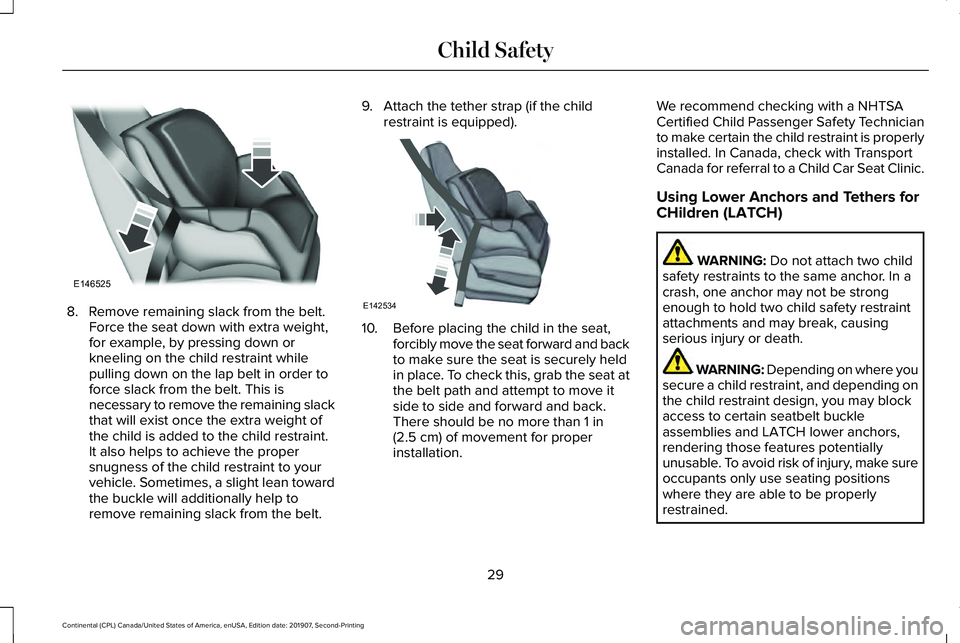
8. Remove remaining slack from the belt.
Force the seat down with extra weight,
for example, by pressing down or
kneeling on the child restraint while
pulling down on the lap belt in order to
force slack from the belt. This is
necessary to remove the remaining slack
that will exist once the extra weight of
the child is added to the child restraint.
It also helps to achieve the proper
snugness of the child restraint to your
vehicle. Sometimes, a slight lean toward
the buckle will additionally help to
remove remaining slack from the belt. 9. Attach the tether strap (if the child
restraint is equipped). 10. Before placing the child in the seat,
forcibly move the seat forward and back
to make sure the seat is securely held
in place. To check this, grab the seat at
the belt path and attempt to move it
side to side and forward and back.
There should be no more than 1 in
(2.5 cm) of movement for proper
installation. We recommend checking with a NHTSA
Certified Child Passenger Safety Technician
to make certain the child restraint is properly
installed. In Canada, check with Transport
Canada for referral to a Child Car Seat Clinic.
Using Lower Anchors and Tethers for
CHildren (LATCH)
WARNING:
Do not attach two child
safety restraints to the same anchor. In a
crash, one anchor may not be strong
enough to hold two child safety restraint
attachments and may break, causing
serious injury or death. WARNING: Depending on where you
secure a child restraint, and depending on
the child restraint design, you may block
access to certain seatbelt buckle
assemblies and LATCH lower anchors,
rendering those features potentially
unusable. To avoid risk of injury, make sure
occupants only use seating positions
where they are able to be properly
restrained.
29
Continental (CPL) Canada/United States of America, enUSA, Edition date: 201907, Second-Printing Child SafetyE146525 E142534
Page 42 of 609

•
Height adjuster at the front outboard
seating positions.
• Seatbelt pretensioner at the front
outboard seating positions.
• Belt tension sensor at the front outboard
passenger seating position. •
Seatbelt warning light and chime. •
Crash sensors and monitoring system
with readiness indicator.
The seatbelt pretensioners and rear
inflatable seatbelts are designed to activate
in frontal, near-frontal and side crashes, and
in rollovers. The seatbelt pretensioners at
the front seating positions are designed to
tighten the seatbelts firmly against the
occupant’ s body when activated. This helps
increase the effectiveness of the seatbelts.
In frontal crashes, the seatbelt pretensioners
can be activated alone or, if the crash is of
sufficient severity, together with the front
airbags. FASTENING THE SEATBELTS
Standard belts shown, inflatable belts similar
The front outermost and rear safety restraints
in the vehicle are combination lap and
shoulder belts.
1. Insert the belt tongue into the proper
buckle (the buckle closest to the direction
the tongue is coming from) until you hear
a snap and feel it latch. Make sure you
securely fasten the tongue in the buckle. 2. To unfasten, press the release button
and remove the tongue from the buckle.
Using Seatbelts During Pregnancy WARNING: Always ride and drive
with your seatback upright and properly
fasten your seatbelt. Fit the lap portion of
the seatbelt snugly and low across the
hips. Position the shoulder portion of the
seatbelt across your chest. Pregnant
women must follow this practice. See the
following figure.
39
Continental (CPL) Canada/United States of America, enUSA, Edition date: 201907, Second-Printing SeatbeltsE71880 E67017 E142587 E142588
Page 45 of 609

Note:
The rear inflatable seatbelts are
compatible with most infant and child safety
car seats and belt positioning booster seats
when properly installed. This is because they
are designed to fill with a cooled gas at a
lower pressure and at a slower rate than
traditional airbags. After inflation, the
shoulder portion of the seatbelt remains cool
to the touch.
The rear inflatable seatbelt consists of the
following:
• An inflatable bag in the shoulder seatbelt
webbing.
• Lap seatbelt webbing with automatic
locking mode.
• The same warning light, electronic
control and diagnostic unit as used for
the front seatbelts.
• Impact sensors in various parts of the
vehicle. How does the rear inflatable seatbelt
system work? WARNING: If a supplementary
restraint system component has deployed,
it will not function again. Have the system
and associated components inspected as
soon as possible. Failure to follow this
instruction could result in personal injury
or death.
The rear inflatable seatbelts function like
standard restraints in everyday usage. During a crash of sufficient force, the
inflatable belt inflates from inside the
webbing.
The fully inflated belt's increased diameter
more effectively holds the occupant in the
appropriate seating position, and spreads
crash forces over more area of the body than
regular seatbelts. This helps reduce pressure
on the chest and helps control head and
neck motion for passengers.
42
Continental (CPL) Canada/United States of America, enUSA, Edition date: 201907, Second-Printing SeatbeltsE146364 E146365
Page 47 of 609
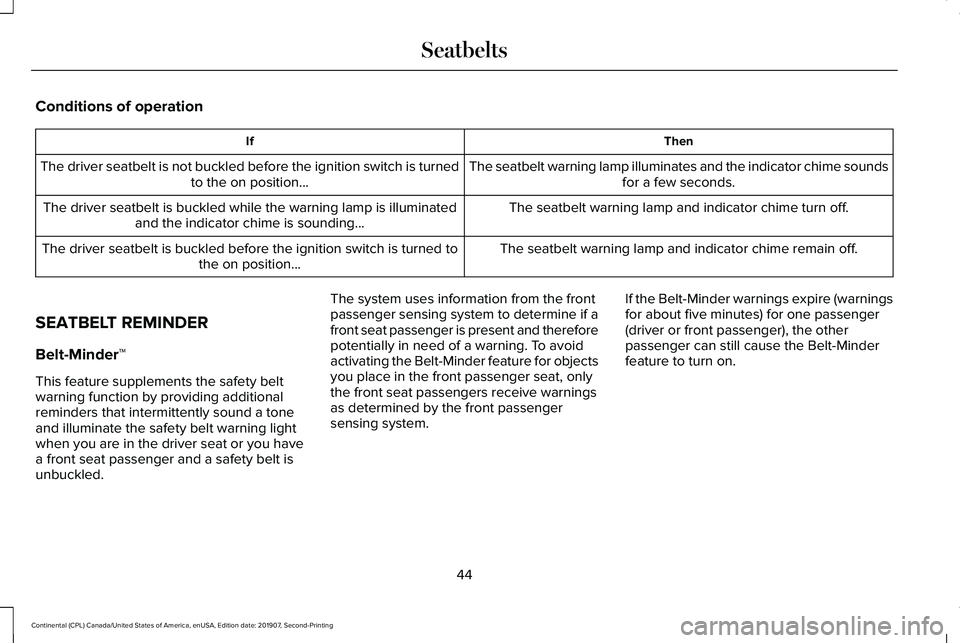
Conditions of operation
Then
If
The seatbelt warning lamp illuminates and the indicator chime soundsfor a few seconds.
The driver seatbelt is not buckled before the ignition switch is turned
to the on position...
The seatbelt warning lamp and indicator chime turn off.
The driver seatbelt is buckled while the warning lamp is illuminated
and the indicator chime is sounding...
The seatbelt warning lamp and indicator chime remain off.
The driver seatbelt is buckled before the ignition switch is turned to
the on position...
SEATBELT REMINDER
Belt-Minder™
This feature supplements the safety belt
warning function by providing additional
reminders that intermittently sound a tone
and illuminate the safety belt warning light
when you are in the driver seat or you have
a front seat passenger and a safety belt is
unbuckled. The system uses information from the front
passenger sensing system to determine if a
front seat passenger is present and therefore
potentially in need of a warning. To avoid
activating the Belt-Minder feature for objects
you place in the front passenger seat, only
the front seat passengers receive warnings
as determined by the front passenger
sensing system.
If the Belt-Minder warnings expire (warnings
for about five minutes) for one passenger
(driver or front passenger), the other
passenger can still cause the Belt-Minder
feature to turn on.
44
Continental (CPL) Canada/United States of America, enUSA, Edition date: 201907, Second-Printing Seatbelts
Page 48 of 609
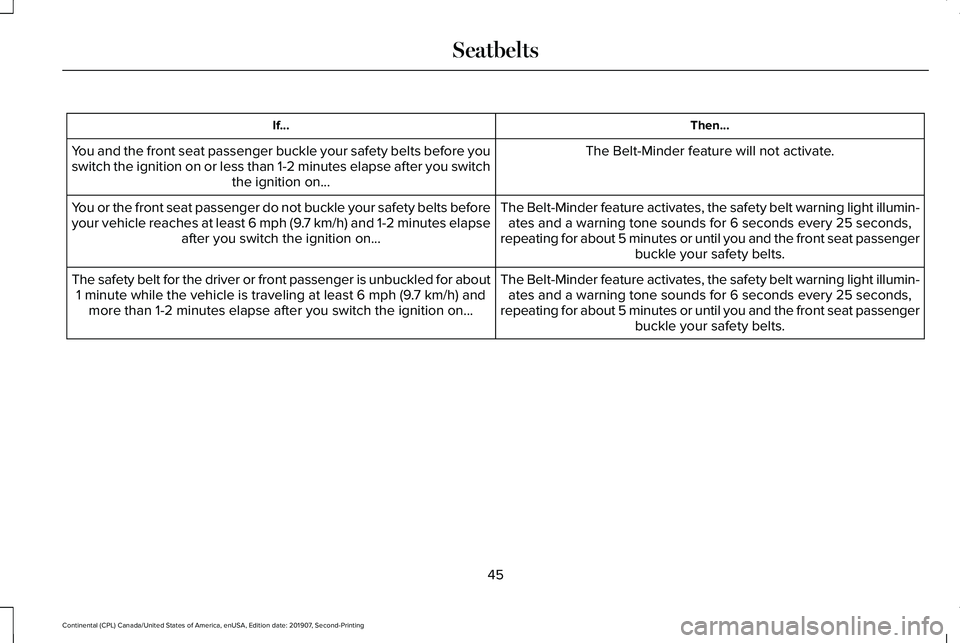
Then...
If...
The Belt-Minder feature will not activate.
You and the front seat passenger buckle your safety belts before you
switch the ignition on or less than 1-2 minutes elapse after you switch
the ignition on...
The Belt-Minder feature activates, the safety belt warning light illumin\
-ates and a warning tone sounds for 6 seconds every 25 seconds,
repeating for about 5 minutes or until you and the front seat passenger buckle your safety belts.
You or the front seat passenger do not buckle your safety belts before
your vehicle reaches at least 6 mph (9.7 km/h) and 1-2 minutes elapse
after you switch the ignition on...
The Belt-Minder feature activates, the safety belt warning light illumin\
-ates and a warning tone sounds for 6 seconds every 25 seconds,
repeating for about 5 minutes or until you and the front seat passenger buckle your safety belts.
The safety belt for the driver or front passenger is unbuckled for about\
1 minute while the vehicle is traveling at least 6 mph (9.7 km/h) and more than 1-2 minutes elapse after you switch the ignition on...
45
Continental (CPL) Canada/United States of America, enUSA, Edition date: 201907, Second-Printing Seatbelts
Page 49 of 609
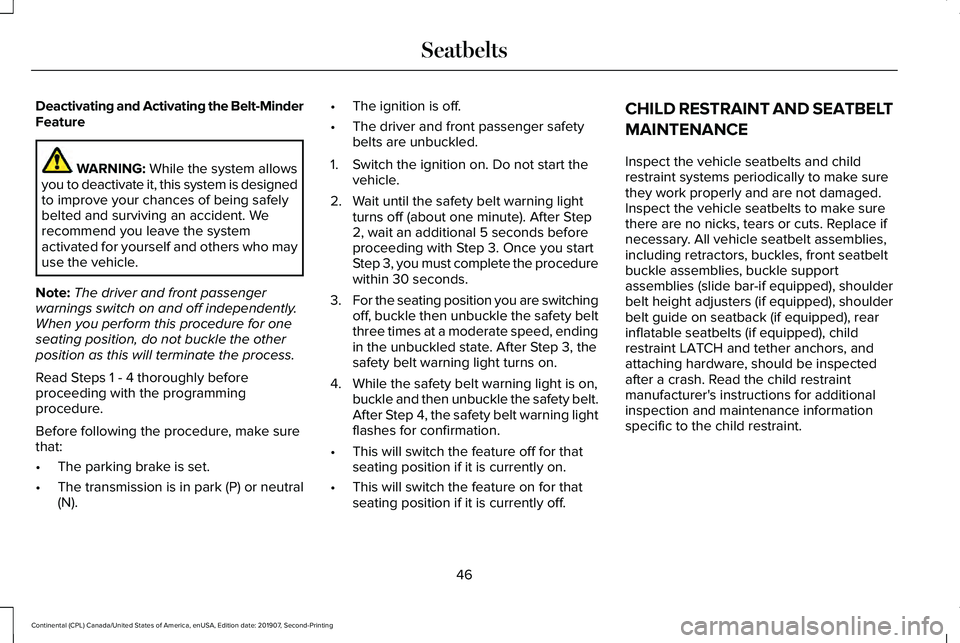
Deactivating and Activating the Belt-Minder
Feature
WARNING: While the system allows
you to deactivate it, this system is designed
to improve your chances of being safely
belted and surviving an accident. We
recommend you leave the system
activated for yourself and others who may
use the vehicle.
Note: The driver and front passenger
warnings switch on and off independently.
When you perform this procedure for one
seating position, do not buckle the other
position as this will terminate the process.
Read Steps 1 - 4 thoroughly before
proceeding with the programming
procedure.
Before following the procedure, make sure
that:
• The parking brake is set.
• The transmission is in park (P) or neutral
(N). •
The ignition is off.
• The driver and front passenger safety
belts are unbuckled.
1. Switch the ignition on. Do not start the vehicle.
2. Wait until the safety belt warning light turns off (about one minute). After Step
2, wait an additional 5 seconds before
proceeding with Step 3. Once you start
Step 3, you must complete the procedure
within 30 seconds.
3. For the seating position you are switching
off, buckle then unbuckle the safety belt
three times at a moderate speed, ending
in the unbuckled state. After Step 3, the
safety belt warning light turns on.
4. While the safety belt warning light is on, buckle and then unbuckle the safety belt.
After Step 4, the safety belt warning light
flashes for confirmation.
• This will switch the feature off for that
seating position if it is currently on.
• This will switch the feature on for that
seating position if it is currently off. CHILD RESTRAINT AND SEATBELT
MAINTENANCE
Inspect the vehicle seatbelts and child
restraint systems periodically to make sure
they work properly and are not damaged.
Inspect the vehicle seatbelts to make sure
there are no nicks, tears or cuts. Replace if
necessary. All vehicle seatbelt assemblies,
including retractors, buckles, front seatbelt
buckle assemblies, buckle support
assemblies (slide bar-if equipped), shoulder
belt height adjusters (if equipped), shoulder
belt guide on seatback (if equipped), rear
inflatable seatbelts (if equipped), child
restraint LATCH and tether anchors, and
attaching hardware, should be inspected
after a crash. Read the child restraint
manufacturer's instructions for additional
inspection and maintenance information
specific to the child restraint.
46
Continental (CPL) Canada/United States of America, enUSA, Edition date: 201907, Second-Printing Seatbelts